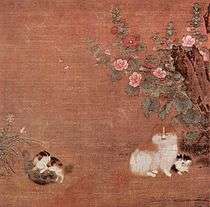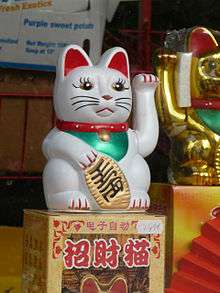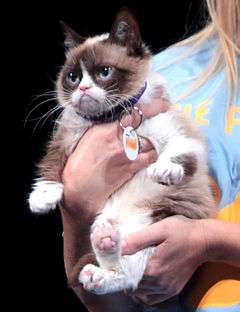Cultural depictions of cats

The cultural depiction of cats and their relationship to humans is as old as civilization and stretches back over 9,500 years. Cats have figured in the history of many nations, are the subject of legend and are a favorite subject of artists and writers.
Earliest history
Cats were originally domesticated because they hunted mice that would eat stored grains, protecting the food stores. It was a beneficial situation for both species: cats got a reliable source of prey, and humans got effortless pest control. This mutually beneficial arrangement began the relationship between cats and humans which continues to this day.
While the exact history of human interaction with cats is still somewhat vague, a shallow grave site discovered in 1983 in Cyprus, dating to 7500 BCE, during the Neolithic period, contains the skeleton of a human, buried ceremonially with stone tools, a lump of iron oxide, and a handful of seashells. In its own tiny grave 40 centimeters (18 inches) from the human grave was an eight-month-old cat, its body oriented in the same westward direction as the human skeleton. Cats are not native to Cyprus. This is evidence that cats were being tamed just as humankind was establishing the first settlements in the part of the Middle East known as the Fertile Crescent.[1]
Ancient Egypt
Cats, known in ancient Egypt as the mau, played a large role in ancient Egyptian society. They were associated with the goddesses Isis and Ba'at.[2] Cats were very commonly depicted in art and routinely mummified.
China
_-_Copy.jpg)

Cats that were favored pets during the Chinese Song Dynasty were long-haired cats for catching rats, and cats with yellow-and-white fur called 'lion-cats', who were valued simply as cute pets.[4][5] Cats could be pampered with items bought from the market such as "cat-nests", and were often fed fish that were advertised in the market specifically for cats.[4][5]
Europe
In Norse mythology, the goddess Freyja was associated with cats. Farmers sought protection for their crops by leaving pans of milk in their fields for Freya's special feline companions, the two grey cats who fought with her and pulled her chariot.[6]
Folklore dating back to as early as 1607 tells that a cat will suffocate a newborn infant by putting its nose to the child's mouth, sucking the breath out of the infant.[7]
Black cats are generally held to be unlucky in the United States and Europe, and to portend good luck in the United Kingdom.[7] In the latter country, a black cat entering a house or ship is a good omen, and a sailor's wife should have a black cat for her husband's safety on the sea.[7][8] Elsewhere, it is unlucky if a black cat crosses one's path; black cats have been associated with death and darkness.[2] White cats, bearing the colour of ghosts, are conversely held to be unlucky in the United Kingdom, while tortoiseshell cats are lucky.[7] It is common lore that cats have nine lives.[7] It is a tribute to their perceived durability, their occasional apparent lack of instinct for self-preservation, and their seeming ability to survive falls that would be fatal to other animals.
Cats were seen as good luck charms by actors, and the cats often helped cure the actors' stage fright.[9]
Classical folklore
The Greek essayist Plutarch linked cats with cleanliness, noting that unnatural odours could make them mad.[10] Pliny linked them with lust,[11] and Aesop with deviousness and cunning.[7]
Middle Ages
Cats were associated with witches, and were killed en masse in the middle of the 14th century during the time of the Black Death. Had this bias toward cats not existed, local rodent populations could have been kept down, lessening the spread of plague-infected fleas from host to host.[12]
Vikings used cats as rat catchers and companions.
A medieval King of Wales, Hywel Dda (the Good) passed legislation making it illegal to kill or harm a cat.[13]
In Medieval Ypres, cats were used in the winter months to control the vermin infesting the wool stored in the upper floors of the Cloth Hall (Lakenhall). At the start of the spring warm-up, after the wool had been sold, the cats were thrown out of the belfry tower to the town square below, which supposedly symbolised "the killing of evil academics". In today's Kattenstoet (Cat Parade), this was commuted to the throwing of woolen cats from the top of out houses and also the people from the Middle Ages used to often suck on the wool as a sign of good luck.
Renaissance and Victorian depictions
In the Renaissance, cats were often thought to be witches' familiars (for example, Greymalkin, the first witch's familiar in Macbeth's famous opening scene), and during festivities were sometimes burnt alive or thrown off tall buildings. Cats became popular and sympathetic characters in such folk tale as Puss in Boots.[14]

One English folk tale in which a cat is given a heroic role is Dick Whittington and His Cat, which has been adapted for many stage works, including plays, musical comedies and pantomimes. It tells of a poor boy in the 14th century, based on the real-life Richard Whittington, who becomes a wealthy merchant and eventually the Lord Mayor of London because of the ratting abilities of his cat. There is no historical evidence that Whittington had a cat,[14] In the tale, Dick Whittington, a poor orphan finds work at the great house of Mr. Fitzwarren, a rich merchant. His little room infested with rats, Dick acquires a cat, who drives off the rats. One day, Mr. Fitzwarren asked his servants if they wished to send something in his ship, leaving on a journey to a far off port, to trade for gold. Reluctantly, Dick sent his cat. In the far-off court, Dick's cat had become a hero by driving very troublesome vermin from the royal court. When Fitzwarren's ship returned, it was loaded with riches. Dick was a rich man. He joined Mr. Fitzwarren in his business and married his daughter Alice, and in time became the Lord Mayor of London.[15]
Japan

In Japan, there is also the saying called the Maneki Neko, also referred to in English as the "good fortune" or "good luck" cat. It is usually a sitting cat with paw raised and bent. Legend in Japan has it that a cat waved a paw at a Japanese landlord, who was intrigued by this gesture and went towards it. A few seconds later a lightning bolt struck where the landlord had been previously standing. The landlord attributed his good fortune to the cat's fortuitous action. A symbol of good luck hence, it is most often seen in businesses to draw in money. In Japan, the flapping of the hand is a "come here" gesture, so the cat is beckoning customers.
There is also a small cat shrine (neko jinja (猫神社)) built in the middle of the Tashirojima island. In the past, the islanders raised silkworms for silk, and cats were kept in order to keep the mouse population down (because mice are a natural predator of silkworms). Fixed-net fishing was popular on the island after the Edo Period and fishermen from other areas would come and stay on the island overnight. The cats would go to the inns where the fishermen were staying and beg for scraps. Over time, the fishermen developed a fondness for the cats and would observe the cats closely, interpreting their actions as predictions of the weather and fish patterns. One day, when the fishermen were collecting rocks to use with the fixed-nets, a stray rock fell and killed one of the cats. The fishermen, feeling sorry for the loss of the cat, buried it and enshrined it at this location on the island.
Another Japanese legend of cats is the nekomata: when a cat lives to a certain age, it grows another tail and can stand up and speak in a human language.
Russia

Cats have been considered good luck in Russia for centuries. Owning a cat, and especially letting one into a new house before the humans move in, is said to bring good fortune.[16]
Many cats have guarded the Hermitage Museum/Winter Palace continually, since Empress Elizabeth's reign, when she was presented by the city of Kazan in Tatarstan five of their best mousers to control the palace's rodent problem.[17] They lived pampered lives and even had special servants until the October Revolution, after which they were cared for by volunteers. Now, they are again looked after by employees.
Africa
Cats are considered a delicacy by the West African Ewe people, who believe that eating cat meat, particularly the head, brings good luck to the eater and would prevent them from dying in a foreign land. In Ghana, cats are often associated with witchcraft and evil. Thus, seeing a black cat in one's dream is considered a bad omen.
Modern culture

Cats have also featured prominently in modern culture. For example, a cat named Mimsey was used by MTM Enterprises as their mascot and features in their logo as a spoof of the MGM lion.[9] As of 1990 cats were the most popular subject depicted on gift items, such as coasters, napkins, jewelry, and bookends. An estimated 1,000 stores in the United States sold nothing but cat-related items.[18]
On the Internet, cats frequently appear often as memes and other humor; and on social media people frequently post pictures of their own cats.
Other
- Muezza (Arabic: معزة) was the Prophet Muhammad's favorite cat. The most famous story about Muezza recounts how the call to prayer was given, and as Muhammad went to put on one of his robes, he found his cat sleeping on one of the sleeves. Instead of disturbing the cat he cut off the sleeve and let him sleep.
- A similar legend states that when Jesus Christ was born, he would not stop crying no matter what anyone did, and what finally calmed him was when a tabby cat jumped into the manger, and its purring lulled him to sleep. The Virgin Mary petted the cat in gratitude, and the "M" on the forehead of the tabby cat is for her name.
- In Celtic Mythology, a Cat Sith is a fairy cat, sith or sidhe (both pronounced shee) meaning fairy.
- In Catholicism, the patron saint of cats is Saint Gertrude of Nivelles.
- The Cat Duet (Duetto buffo di due gatti), attributed to Rossini, is a popular performance piece for two sopranos, whose "lyrics" consist entirely of the repeated word "miau" ("meow").
See also
Notes
- ↑ Carlos A. Driscoll, Juliet Clutton-Brock; et al. (June 2009). "The Evolution of House Cats; Genetic and archaeological findings hint that wildcats became house cats earlier--and in a different place--than previously thought". Scientific American.
- 1 2 Cirlot JE (1967) [1962]. A Dictionary of Symbols. London: Routledge and Kegan Paul. p. 38.
- ↑ "A Chinese Cat-Market". Wesleyan Juvenile Offering. III: 110. October 1846. Retrieved 17 November 2015.
- 1 2 Gernet, 48.
- 1 2 Gernet, 122–123.
- ↑ Howey, M. Oldfield (2003) [1930]. The Cat in Magic and Myth. Mineola, NY: Dover. pp. 58–60. ISBN 9780486431147. Retrieved 26 August 2013.
- 1 2 3 4 5 6 de Vries, Ad (1976). Dictionary of Symbols and Imagery. Amsterdam: North-Holland Publishing Company. pp. 85–86. ISBN 0-7204-8021-3.
- ↑ Eyers, Jonathan (2011). Don't Shoot the Albatross!: Nautical Myths and Superstitions. A&C Black, London, UK. ISBN 978-1-4081-3131-2.
- 1 2 Stall, Sam (2007). 100 Cats Who Changed Civilization: History's Most Influential Felines. Quirk Books. ISBN 978-1-59474-163-0.
- ↑ Plutarch: Adv. on Marr. 44
- ↑ Pliny 10, 83
- ↑ Feline geneticist traces origin of the cat
- ↑ Taking Liberties - Star Items - Laws of Hywel Dda
- 1 2 Roberts, Patrick. "Dick Whittington and his Cat: The myth and the reality", Fabled Felines, purr-n-fur.org (2008)
- ↑ Cruikshank, George. The history of Dick Whittington, Lord Mayor of London: with the adventures of his cat, Banbury, c.1820
- ↑ Moscow Cat Museum
- ↑ Russian Life
- ↑ Dickinson, Ernest (1990-07-22). "All About/Cat Supplies; Billions for Food, And Knicknacks to Boot". The New York Times. Retrieved March 8, 2013.
References
- Gernet, Jacques (1962). Daily Life in China on the Eve of the Mongol Invasion, 1250–1276. Translated by H.M. Wright. Stanford: Stanford University Press. ISBN 0-8047-0720-0.
- Dodge, Alleine (1949). Nine lives: an exhibition of the cat in history and art, New York: Cooper Union Museum for the Arts of Decoration, archive.org
Further reading
- The Cat and the Human Imagination by Katharine M. Rogers; Ann Arbor: University of Michigan Press, 1998. ISBN 9780472108268.
External links
| Wikimedia Commons has media related to Cats in art. |